
Vol. 3, No. 7, July 2007 |
 Printer-Friendly PDF Version Printer-Friendly PDF Version |
Florida Counties Are Organizing!
|
The latest county-level Florida SART affiliate to be formed will be known as the "Northeast Florida Counties Animal Resources Team?or NEFCART.
In addition to inviting our county Emergency Management Directors and concerned businesses and agencies in the region, NEFCART extends an invitation to all interested SART members in the northeast Florida area to attend the next general meeting, tentatively scheduled for 10:00 am August 13th at the St. Johns County EOC; the NEFCART Advisory Board will meet before the general meeting. The St. Johns County EOC is located at 4455 Avenue A, Suite 102, St. Augustine, FL 32095 (904) 824-5550 www.sjcemergencymanagement.org. For additional information contact DeJarnatt at dejarnd@doacs.state.fl.us or Martha Wagaman at Martha_Wagaman@doh.state.fl.us. | |||
[top]
[top]
|
Through the Grapevine
"What we learned from the 2004 hurricanes was that when there is nothing at the local level [no active organization in place], it is much harder for us to come in and be supportive and build anything following a disaster. It is better if we are supporting something that is present already and we are simply augmenting their local system. Laura Bevan
|
Florida VETS Aid Bear Rescue
By now, everyone knows the story of the "Bugaboo Bears," so-called because a
sow black bear and her first-year cub were rescued from the Bugaboo Fire that raged through 125,000 acres of Georgia and Florida during April and May. Florida Fish & Wildlife Conservation Commission veterinarian Mark Cunningham captured the bears and took them to the University of Florida College of Veterinary Medicine for emergency care. The sow suffered third-degree burns to her pads and the cub was perilously dehydrated. Without rescue, both bears would almost certainly have perished.
According to Sarah Carey, UF College of Veterinary Medicine public information specialist, "everything went flawlessly. When the bears arrived at our Veterinary Medical Center, veterinarians with our zoological medicine service provided initial wound care to the adult bear and monitored both bears for signs of lung damage from smoke inhalation. Thankfully, there was no such damage and the bears' conditions improved even in the short time they were with us, about a week. At that time, they were taken to Disney World's Animal Kingdom, where they remained for
another month or so receiving follow-up treatment.

The cub sits in the tallest pine tree in the area.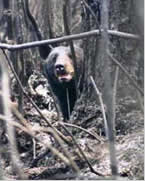
The sow (mother bear) watches from beneath the cub's tree as the FWC capture team arrives.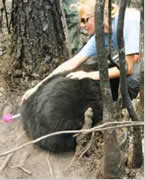
Elina Garrison, research biologist from the FWC's
Gainesville lab, removes the tranquilizer dart from the sow.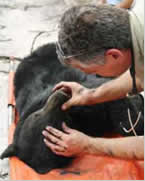
FWC veterinarian Dr. Mark Cunningham examines the sow.
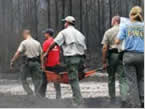
Rescue team carries sow to road for examination.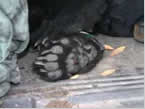
The sow bear's blistered paw.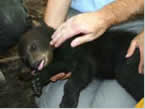
The cub after her rescue from the tree.
Rescuers gather around the cub as Elina Garrison holds her.
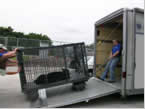
Team from Florida VETS in Gainesville transports the bears.
Freedom! Bears are released back into national forest.Top and middle row photos and captions by Karen Parker, Florida Fish & Wildlife Conservation Commission. Bear loading photo by Sarah Carey. Bear running free photo by Tracy Wilcox, Gainesville Sun newspaper.
"When they were ready to return to the wild, John Haven and David John, both of whom work with the Florida VETS (Veterinary Emergency Treatment Service) program, picked the bears up at Disney and drove them back into the forest. They used the VETS/SART truck and trailer, complete with 12-kw diesel generator capable of providing air-conditioning en-route. Dr. Cunningham's rest-stop checks on mother bear and cub assured him ?and us ?that the two traveled comfortably."
The release in the Osceola National Forest - an "incredible experience," Carey said - was within the bears' original home range. "I'll never see anything like it again, I'm sure."
Jacksonville's ABC affiliate First Coast News (Channel 12) has posted this story at:
http://www.firstcoastnews.com/news/topstories/news-article.aspx?storyid=84654
Additionally the Gainesville Sun newspaper has a story on line. (Note that the UF Class of 1997 veterinarian at Disney's Animal Kingdom is Steve Terrell, not Scott Terrell.)
http://gainesville.com/apps/pbcs.dll/gallery?Avis=GS&Dato=20070619&Kategori=NEWS&Lopenr=619004&Ref=PH
Thanks also to the Florida Fish & Wildlife Conservation Commission's Karen Parker who has posted photos and captions on line at:
http://myfwc.com/whatsnew/07/statewide/bearrescue-photos-1.html.
[top]
Third Annual Southeast Security Conference Is ScheduledThe third annual Southeast Homeland Security Conference is scheduled for the Peabody Hotel, Orlando, December 10-14. According to Rick Moore (rmore@co.volusia.fl.us), Planner II with the Volusia County Division of Emergency Management who has served as the conference's Educational Chair since its inception, the itinerary is being finalized and will soon be posted on-line at www.sehomelandsecurityconference.com/index.htm. (Watch for follow-up and site information in the August SART Sentinel.) Registration information is available from Diana Wright at dwright@nettally.com.
Today, she oversees food safety, the regulation of pesticides and pest control companies; feed, seed and fertilizer production, inspection, and testing; issues related to Florida's dairy production, quality and distribution; and FDACS?role in domestic security issues. | |||||||
[top]
Seven Florida Counties Primary Natural Disaster Areas
Farmers and Ranchers May Apply for USDA Assistance
The US Department of Agriculture has designated seven Florida counties primary natural disaster areas because of freezing temperatures February 17-19, 2007:
 | Palm Beach is designated a primary area and also eligible because they are contiguous are Broward, Hendry and Martin. |
Designated natural disaster areas on May 29, qualified farm operators are eligible for low interest emergency (EM) loans from USDA's Farm Service Agency (FSA), provided eligibility requirements are met. Farmers in eligible counties have eight months to apply for loans to help cover part of their actual losses. FSA considers each loan application on its own merits, considering the extent of losses, security available and repayment ability. FSA has a variety of programs, in addition to the EM loan program, to help eligible farmers recover from adversity. |  A cold snap at the right time will increase the sugar content of citrus, but an ill-timed freeze will ruin a crop. |
[top]
|
Through the Grapevine
"Yes, we struggle a bit with the plant and aquaculture issues because they have a whole different agenda for emergencies. For instance, farmers may need weight restrictions on bridges and roads lifted temporarily so they can get crops out and away in a hurry. Greg Christy, DVM
|
Clay County Requests Volunteer Aids
According to an Email from SART member Martha Wagaman of the Duval County Health Dept. Emergency Preparedness Division (Martha_Wagaman@doh.state.fl.us), Clay County is in need of volunteers to assist with the building of ten 4x10 foot runs to house the pets of individuals living at Quigley House in Orange Park (www.quigleyhouse.org).
Quigley House is Clay County's domestic violence/abuse shelter. Some of the building supplies (chain link fence and 10 yards of concrete) have been donated from local businesses but the manpower to assemble the facility is desperately needed. Without the addition of these runs, pets belonging to victims seeking refuge at the shelter will have to be surrendered to the county animal control facility, which is unable to house the animals for more than three days. Please contact Annie Henderson, Animal Cruelty Investigator for Clay County, via email (AHenderdson@claysheriff.com) for more information or to volunteer! |
 |
[top]
Red Cross Completes Hurricane Zeus Exercise | ||
 | ||
 |  |  |
| Hurricane Zeus prepares to come ashore in north Florida during the Red Cross disaster preparedness and response exercise in May. | ||
Although the Tampa Bay Chapter of the American Red Cross was not involved with Hurricane Zeus, the chapter's mission statement exemplifies Red Cross ideals and standards: "The American Red Cross, a humanitarian organization led by volunteers and guided by its Congressional Charter and the Fundamental Principles of the International Red Cross Movement, will provide relief to victims of disasters and help people prevent, prepare for, and respond to emergencies.?www.redcrosstbc.org
To prepare for a significant weather event, the Capital Area Chapter of the Florida Red Cross recently organized and conducted an exercise called "Hurricane Zeus?in cooperation with eight north Florida and nine southwest Georgia counties. Zeus tested the ability of Red Cross Chapters and their partner organizations to initiate disaster response and recovery activities as a category two storm approaches and subsequently passes through North Florida and Southwest Georgia by:
- conducting needs and damage assessments,
- managing both general population and special needs shelters,
- establishing and staffing distribution points,
- managing logistical warehouse activities,
- establishing and staffing Emergency Aid Stations and
- sharing information using a variety of communications systems.
"This exercise truly put our volunteers and the paid staff of partner organizations through their paces,?says Chris Floyd, director of the Capital Area Chapter,?but it was all in an effort to prepare for the 2007 Hurricane Season.?br>
And so ?how did they do? "Florida's Red Cross chapters are, by and large, very strong and will need relatively little pre-landfall assistance,?says Wayne Brennessel, Director of Disaster Relief Operations, American Red Cross. "For long term support, however, we are always prepared to bring in a lot more resources.?br>
Brennessel stressed that Chris Floyd and many others worked very hard to develop a credible exercise. "The exercise was a very valuable experience,?Brennessel stressed, "and it has helped us all better understand and appreciate chapter capacity and where human and material resources will be needed to support pre- and post-landfall relief efforts.
"I also appreciate the time everyone devoted to the exercise, especially knowing how full people's plates are this time of year. We certainly wish for a quiet Hurricane Season, but knowing the level of preparedness throughout the State of Florida will help us all anticipate and prepare for the inevitable.?br>
To follow the Zeus time-line and study some of the on-line materials, go to http://redcross.tallytown.com/zeus/.
[top]
|
Through the Grapevine "Think of the guy with the hole in his roof who looks up and, seeing sunshine, says, 'I don't need to get around to fixing that today.?Then when it starts raining, he runs around to the garage to get his tools and saws and boards out to fix the hole, but his roof is already leaking. I believe that it is better to have an organization like SART and never need it, never need to activate it, than to need it and not have it. And doing it later may just be too late. We're trying to change people's mindset from simply recovery from a disaster to planning and preparing, because if you have prepared and organized then, when the time comes, response and recovery will be faster and smoother.? Tim Manning
|
Exotic Update: Citrus Psyllid
Bugs. They aren't very sexy to talk or think about even if they are ?from a scientific perspective, at least ?intricate and amazing works of art. The invasive, exotic citrus psyllid ?a tiny "bug?half the size of your smallest fingernail ?threatens to destroy the productiveness of Florida's citrus industry because it carries a disease called citrus greening. Photo David Caldwell, IFAS/UF |
It is much more fun to scare ourselves about pythons in the Everglades and monitor lizards in Lake Apopka or even our semi-annual plague of "love bugs.?Nevertheless, exotic insects pose a much greater threat to our animal and agricultural infrastructure in Florida than do all the introduced reptilians ?unless the Creature from the Black Lagoon makes a comeback. |
throughout Florida. Injury caused by these tiny bugs results from the withdrawal of large quantities of sap from the foliage, and transmission of the organisms that cause Citrus Greening disease. This psyllid has already had dramatic impacts in other countries. The once flourishing citrus industry in India is slowly being wiped out by dieback. This dieback has multiple causes but is primarily due to greening disease. What is now generally accepted as greening disease has been called citrus chlorosis in Java, leaf-mottling and leaf-mottle yellows in the Philippines, likubin (rapid decline) in Taiwan, and huang long bing (yellow dragon disease) in China.
To learn more about citrus psyllid and its potential impact on Florida's citrus industry, please check the SART Training Module "Three Exotic Plant Diseases Threatening Florida.?www.flsart.org/library/index.htm#PD6
[top]
Planning Maps Are Available
A recent Email from Chris Floyd, Chief Operations Officer for the Capital Area Chapter of the American Red Cross notes that county planning maps in PDF format for hurricane evacuation and storm surge are now available on line.- Hurricane Evacuation: http://redcross.tallytown.com/map/evacuation.html
- County Storm Surge Maps http://redcross.tallytown.com/map/surge.html
[top]
Pet Happy Hour on NC Outer Banks
Quin Capps does PR for North Carolina's Outer Banks. He sent this Email about a pet shop named the "Outer Barks,?which specializes in dogs. I've edited it for length, but it seems like an amusing way to end this mid-summer Heat Stroke issue of the SART Sentinel. Stay cool ?
-------------------------
Every week, from March to Thanksgiving, the Outer Barks hosts Yappy Hour. Co-owner Kevin Carey says, "Yappy Hour provides humans and their canine fur-kids the opportunity to mingle, enjoy some treats and celebrate the human/canine bond.?
The gathering includes agility equipment, beach music, a baby pool with float toys and an art studio where dogs can create a paw painting to take home as a memento. The buffet offers treats such as turkey frittata, a ginger applesauce bone cake, blueberry muffins and Italian meatballs. These goodies are washed down with a Doggie Daiquiri or Muttguarita. |  Dogs and owners visiting North Carolina's Outer Banks make friends during the Yappy Hour Cocktail Hour at Outer Barks in Duck. Photo courtesy Outer Barks |
[top]
About the SART Sentinel
Editor: Rick Sapp, PhD, Technical Writer, Florida Department of Agriculture & Consumer Services, Division of Animal Industry [rsa5@cox.net]
Associate Editor: Joe Kight, State ESF-17 Coordinator, Florida Department of Agriculture & Consumer Services, Division of Animal Industry [kightj@doacs.state.fl.us]
The SART SENTINEL is an E-mail newsletter prepared monthly by Rick Sapp and the members of the Florida State Agricultural Response Team. Past issues of the Sentinel are archived on the Florida SART Web Site, www.flsart.org.
If you have a story or photo that you would like to have considered for publication in The SART SENTINEL, please contact the Editors.






